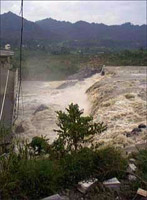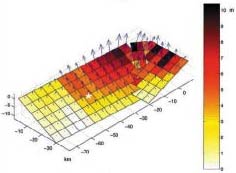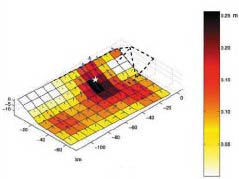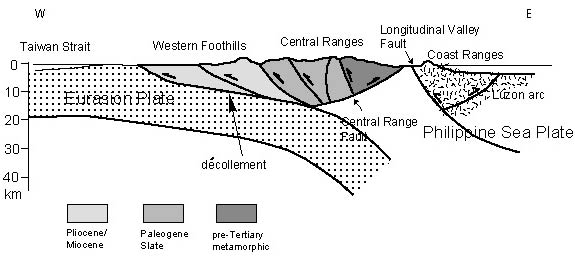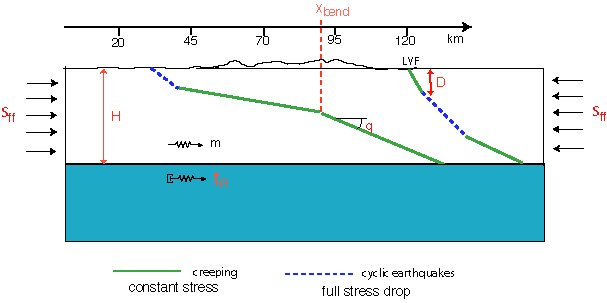|
|
|
Collisional Tectonis, Taiwan
We have been studying crustal deformation and fault mechanics
in continental collision environments, such as Taiwan.
On 21 September, 1999 a Mw=7.5 earthquake occurred near the city of
Chi-Chi in western Taiwan. This thrust event ruptured over 100 km of
the north-south trending Chelungpu fault. Horizontal displacements
determined from GPS observations before and after the earthquake
increase from 1 m at the southern end of the rupture to 11 m at the
northern end. Vertical displacements were largest near the fault trace,
where the hanging wall was uplifted as much as 4.4 meters. The figure
shows a waterfall that formed near the northern end of the fault, where
the eastern hanging-wall side was uplifted by 6 meters. We have
analyzed the coseismic displacements to determine the subsurface
geometry of the Chelungpu fault, as well as the distribution of slip on
the fault, shown by the figure below.
We find that the shallow, 30 degree dipping fault soles into a
decollement at a depth of roughly 8 km. Slip is concentrated at shallow
depth at the very northern end of the rupture where the fault breaks
turn to the east. This south dipping lateral ramp is required to fit
the GPS data (Johnson et al, 2004).
Post earthquake displacements of as much as 14 cm were
recorded in the 3 months following the earthquake. The horizontal
displacements are consistent with the earthquake deformations, with
convergence toward the fault trace. Farther from the fault the hanging
wall subsided after the earthquake. Various mechanisms have been
proposed to explain postseismic deformation including: viscoelastic
relaxation of the lower crust or upper mantle, poroelastic relaxation
due to pore-fluid flow, and afterslip. Only afterslip seems to fit the
data observed in Taiwan.
Viscoelastic models predict convergence toward the down-dip end of the
fault, rather than toward the fault trace as observed. Simple
poroelastic calculations predict deformation concentrated near the ends
of the fault, contrary to the observations. Afterslip alone provides a
good fit to the observations. Inverting the post-earthquake
displacements, we find that transient slip was localized around the
area of maximum coseismic slip (Hsu et al, 2002, and figure on the
right). This is consistent with the expectation that post-earthquake
slip is caused by the earthquake static stress change.
We are also studying the interseismic pattern of deformation
in an effort to determine the geometry of faults beneath the
seismogenic zone, and how they are loaded by the Collision between the
Philippine Sea Plate and the Eurasian Plate (see figure below).
Simple elastic dislocation models can not fit the data, in particular
the vertical displacement patterns in eastern Taiwan. We have developed
mechanical models of repeating earthquake cycles on dip-slip faults.
The models assume an elastic crust overlying a Maxwell viscoelastic
region.
The faults in the lower crust creep in response to imposed
stresses. The shallow faults (<10 km depth) slip in large
earthquakes with repeat times determined by historical seismicity. The
system is loaded by far-field stresses in the elastic layer.
These models fit the data far better than the elastic
dislocation models.
The best fitting models have east dipping frontal faults
merging into a decollement which dips gently beneath the central ranges
(see figure on the left).
The active Longitudinal Valley fault may merge with the
decollement into a single master thrust east of Taiwan.
References
 Johnson, K.M., and P. Segall, Imaging the
ramp-decollement geometry of the Chelungpu fault using coseismic GPS
displacements from the 1999 Chi-Chi, Taiwan earthquake, Tectonophysics,
378, 123-139, 2004. Johnson, K.M., and P. Segall, Imaging the
ramp-decollement geometry of the Chelungpu fault using coseismic GPS
displacements from the 1999 Chi-Chi, Taiwan earthquake, Tectonophysics,
378, 123-139, 2004.
 Hsu, Y.-J., N. Bechor, P. Segall, S.-B. Yu, and K.-F.
Ma, Rapid afterslip following the 1999 Chi-Chi, Taiwan earthquake, Geophys.
Res. Lett., 29, doi:10.1029/2002GL014967, 2002. Hsu, Y.-J., N. Bechor, P. Segall, S.-B. Yu, and K.-F.
Ma, Rapid afterslip following the 1999 Chi-Chi, Taiwan earthquake, Geophys.
Res. Lett., 29, doi:10.1029/2002GL014967, 2002.
|



